25 April 2023
LACROIX Environment
The Nevers Agglomeration water network
The Nevers Agglomeration water and sanitation department manages the supply of drinking water to 13 member municipalities.
11 catchment points draw water from the water table and supply the 5 treatment plants with water that fully complies with drinking water standards. The treated water is sent to 14 reservoirs in charge of storing it and regulating the pressure once the water is distributed. The Nevers Agglomeration distribution network extends over 685 km and serves 31,000 consumers as well as the public facilities of the municipalities.
A large part of these works is monitored and controlled remotely by local SOFREL S4W stations also ensuring the cyber security of the remote management network.


The smart city that brings together smart water, smart mobility and smart energy is part of a line of thinking for the Agglomeration.
Water and energy savings and mobility limiting nuisances and Co2 emissions are part of the natural environment of the 85,000 inhabitants of Nevers Agglomeration for the years 2020 to 2050.
LACROIX totally corresponds to the idea that we have of the technological evolution and its contributions for a territory like Nevers Agglomeration.
20% additional yield in less than 6 years
 In order to reduce water losses as much as possible the water department has invested in a sectorization of its network. 70 remotely read meters have been installed to mesh the water distribution network.
In order to reduce water losses as much as possible the water department has invested in a sectorization of its network. 70 remotely read meters have been installed to mesh the water distribution network.
SOFREL LS data loggers monitor the nightly flows and alerts on a daily basis to the teams in case of consumption drift. The investment paid for itself very quickly thanks to reductions in water losses and energy expenses that led to a 20% increase in efficiency.
Testimonial
Dominique DERANGERE
Head of the Water and Sanitation Department - Nevers Agglomeration
Fabrice PACCAMICCIO
Manager of the Water Department - Nevers Agglomeration
-
Can you tell us about the many performance points you have achieved?
 D.D. :
D.D. :Yields in 2014 were clearly insufficient and did not reach the thresholds necessary to qualify for subsidies from the Water Agency. They were just above the yields decreed by the Grenelle law. From 74%, thanks to the network and remote management, the network yield obtained in 2020 will exceed 94%.
-
You have deployed many local stations and SOFREL data loggers on your facilities. What do they bring to the control room teams?
 F.P. :
F.P. :At present, we make full use of the SOFREL S500 and S4W local stations for data acquisition, reporting to supervision, alarm reporting, inter-site communications, etc. We use the automation functions for automatic pump switching, frequency and pressure variation. The S4W in particular responds to cybersecurity issues. It allows us to communicate entirely in IP in a secure way and to give access to authorized persons.
The SOFREL LS allows us to follow daily what is happening on the water distribution network, to archive information and to see the evolution of the flow through the meters.
The strong points of SOFREL products are to be able to connect everything, to automate everything… the only limitations of the products are in fact those that we inject ourselves with our lack of skills or imagination. -
Keeping a close eye on water consumption is an essential point for the department.
 D.D. :
D.D. :The interest of all this telemetry is to bring a better service to our subscribers, in particular the “big consumers”. For example, the USON rugby stadium, soccer stadiums, schools, retirement homes, etc., where water supply problems and consumption control are really important. By managing to sectorize, to follow and to remotely monitor our networks, we are able, if not to anticipate, at least to react very quickly in case of consumption drifts.
-
What are the savings made thanks to remote management?
 D.D. :
D.D. :It’s been estimated that since 2014 productivity gains in yields have caused us to save 200,000 m3 of water each year. Right now, given climate change that’s something we’re particularly proud of. These results encourage us to continue over time.
From a financial point of view, if we take into account all the water we did not have to produce unnecessarily it is also 130 MW that is saved thanks to this remote monitoring.
Plus d'articles

Case study
How Nevers Agglomeration Increased Efficiency on its Water Network by 20%

Explained
Reducing non-revenue water

Expert's take
Water pressure regulation to save water and energy

Innovation
SOFREL S4W a new RTU for hydraulic structures management

Smart Technologies



